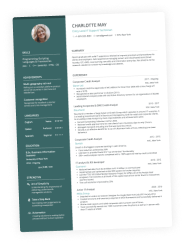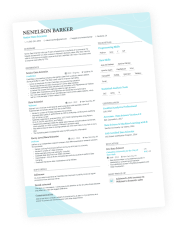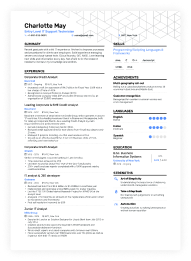When it comes to preparing your resume, it turns out that something as simple as listing dates can present a challenge.
For example, should you mention months or just years? How should you address employment gaps? What about work experience that’s in the distant past?
These details can influence how hiring managers see your application. So if you’re unsure how to include dates on a resume—or if you’re worried you might hurt your chances because of some mistake—then you’ll find this guide helpful.
Key takeaways
- Keep your date format consistent throughout your entire resume.
- Use month and year for clarity, or just years if space or simplicity is needed.
- Format dates clearly so applicant tracking systems can read them properly.
- Match your date formatting to your resume style—chronological or functional.
- Include education dates if they’re recent or relevant, otherwise leave them off.
- Be honest about employment gaps and explain them briefly if they’re long.
- Focus on the most recent 10–15 years and avoid listing outdated experience.
Why are dates important on a resume?
Resume dates are important because they help hiring managers to better understand your experience and qualifications. They provide a clear picture of your career timeline.
In short, listing dates correctly is about presenting your experience accurately and organizing it for the benefit of recruiters.
The role of dates in work experience
Dates on your resume tell a story. When listed properly, they tell employers how long you stayed in your previous roles, how your career developed, and whether you’ve taken on more responsibilities along the way.
For example, if you’ve stayed in a role for several years, then this communicates commitment and stability to hiring managers. These qualities are valued by traditional organizations where long-term commitment is seen as an advantage.
On the other hand, shorter periods between roles can signal flexibility and adaptability. However, there’s a trade-off. If the time spent in each job is unusually brief, employers might view it as a red flag and wonder if you're a job hopper.
Essentially, dates set up certain expectations about you. If you claim to have over ten years of experience in a certain field, then you should back it up with specific dates. This will support your claim and give credibility to your career.
ATS and date formatting
Nowadays, many companies use applicant tracking systems (ATS) in their recruitment process. They scan dates to categorize your work history.
Therefore, if there’s something unusual about your date formatting, a system might not understand your content as you intended it to.
This means it might be harder for your resume to pass through automated screening if your dates are messed up or missing. Your experience might be overlooked and your resume will be rejected.How to format dates on a resume
Formatting the dates on your document might seem like a minor detail but it plays a role in how your professional experience is interpreted.
Here’s what you should focus on:
Date formatting for ATS readability
- Stick to months and years only: There’s no need to add full dates. It”ll only clutter your document unnecessarily.
- Align the dates clearly: Place the dates on the right side after each job title or right under them.
- Be consistent: Pick one date format and keep it throughout your resume.
- Watch your spacing and punctuation:Always place a space before hyphens (-) in your date ranges. Stick to standard characters—avoid slashes that curve backwards, unusual symbols, or auto-styled fonts that can throw off scanning.
Standard resume date formats
There’s no universal rule about resume formats but these are widely accepted:
- Numbered month, forward slash and year (03/2020 - 06/2026): Enhancv’s resume builder uses this format. It optimizes space and eases readability.
- Abbreviated month and year (Mar 2020 - Jun 2026): It’s fine to use abbreviations on your resume, especially for month names. This format looks great on modern minimalist resume templates.
- Long form month and year (March 2020 - June 2026): Full month names can be used in traditional resume templates, so you can opt for this approach when applying for roles in academia, government, or law.
- Year only (2020 - 2026): Suitable when you want to simplify your timeline. It can be used for older roles after a prolonged gap in employment.
Want to be sure your formatting holds up? Use a tool like Enhancv’s AI Resume Builder to see how your resume is interpreted by ATS software before you send it off.
Chronological vs. functional resume dates formatting
Another factor that can dictate how you format the dates on your resume is the resume format itself. Each format presents your timeline differently and this affects how and where the dates will be placed.
Chronological format
- Dates are essential in a chronological resume.
- Use consistent date formatting.
- Aligned the dates properly to ease readability.
- Always include the start and end dates for each role.
Functional format
- Dates are not as important in a functional resume.
- This format focuses on skills and accomplishments rather than work history.
- You can list your experience in a simple section at the bottom of your document.
- It’s acceptable to specify only the years in your work history.
- There’s no need to place dates in your “Skills” or “Accomplishments” sections.
To give you a quick visual reference, here’s how dates should appear on your resume:
Visual examples of properly formatted dates
| Resume entry example | Why this formatting is effective |
|---|---|
| Software Engineer XYZ Technologies Mar 2020 – Apr 2024 |
|
| Marketing Consultant (Freelance) Self-employed Jan 2022 – Present |
|
| Retail Sales Associate (Seasonal) Store ABC Nov 2023 – Jan 2024 |
|
Always align your dates consistently to the right-hand side or directly below your job titles to improve readability at a glance.
Now that you know how to format dates cleanly, let's look at how to handle non-traditional work experience like freelance or seasonal jobs.
How to list seasonal work and freelance projects
Not every job fits neatly into a traditional timeline. If you’ve held seasonal jobs, contract roles, or worked as a freelancer, it’s important to present those experiences clearly and professionally on your resume.
Here’s how you can format non-traditional work experience:
Formatting non-traditional work experience
| Example | Advice |
|---|---|
Seasonal jobs:
| When listing seasonal positions, you can add the season to the date range for extra clarity. |
Freelance or contract work:
| List freelance work like any other job. You can either group it under a general heading (e.g., “Freelance Graphic Designer”) or list major contracts individually if they were long-term. |
If you’ve freelanced for multiple clients during the same period, show continuity by stating the overall date range rather than listing each short project separately.
Don’t leave freelance or seasonal work off your resume just because it’s non-traditional. Instead, format it professionally to show your skills, reliability, and experience handling diverse projects.
How to handle employment gap dates
Be it due to personal circumstances, travel, or layoffs, gaps in work history can occur. There’s no need to panic about them. Here’s how you can approach this.
Do you need to explain employment gaps?
You don’t need to always explain employment gaps in your resume. It depends on the length and context. A gap of a month or two won’t raise any eyebrows, so you can safely skip explaining it.
However, a longer gap—from six months to a year—should be briefly addressed in your resume. You don’t need to share personal details about the gap—a simple explanation with a generic reason would suffice.
How to address career breaks on your resume effectively
You can frame your work history gap in a positive way by mentioning how it contributed to your growth. For example, if you took a course, volunteered, or traveled.
Here’s how to include it in your document:
- Label the gap clearly: Put it in your work history, and add a date range and a generic reason.
- Demonstrate initiative: You can mention what valuable skills you’ve obtained during your gap period.
We used Enhancv’s AI-powered resume builder to create this example:
- •Completed a professional certification in project management.
- •Volunteered as a team coordinator for a nonprofit organization, enhancing leadership and collaboration skills.
There’s another important section of your resume where you should be extra careful with dates.
Education and certification dates
Putting dates in your “Education” and “Certifications” sections helps employers to better understand your qualifications. It depends on your career stage and career goals.
Include graduation dates if:
- You’ve graduated recently and your education is a main qualification.
- You’ve completed a relevant certification and you want to highlight its recency.
Leave dates off if:
- You graduated more than a decade ago.
- Your experience is more relevant to the role than your degree.
How to list ongoing education and certifications
It’s perfectly fine to include school and certification details, even if you’re currently progressing through them. This way you show to employers initiative and commitment to learning.
Example:
- B.S. in Computer Science, University of Washington – Graduation expected 2026
- Google UX Design Certificate – In progress (started Jan 2024)
How to handle employment gap dates
Be it due to personal circumstances, travel, or layoffs, gaps in work history can occur. There’s no need to panic about them. Here’s how you can approach this.
Do you need to explain employment gaps?
You don’t need to always explain employment gaps in your resume. It depends on the length and context. A gap of a month or two won’t raise any eyebrows, so you can safely skip explaining it.
However, a longer gap—from six months to a year—should be briefly addressed in your resume. You don’t need to share personal details about the gap—a simple explanation with a generic reason would suffice.
How to address career breaks on your resume effectively
You can frame your work history gap in a positive way by mentioning how it contributed to your growth. For example, if you took a course, volunteered, or traveled.
Here’s how to include it in your document:
- Label the gap clearly: Put it in your work history, and add a date range and a generic reason.
- Demonstrate initiative: You can mention what valuable skills you’ve obtained during your gap period.
We used Enhancv’s AI-powered resume builder to create this example:
- •Completed a professional certification in project management.
- •Volunteered as a team coordinator for a nonprofit organization, enhancing leadership and collaboration skills.
Concerned about age bias? Here's how to handle older dates strategically.
Addressing age discrimination concerns
Should you leave off older dates to avoid age discrimination?
Age discrimination is a real concern for many job seekers, especially those with decades of experience. While it’s important to be transparent on your resume, there's also a strategic way to present your history without opening yourself up to potential bias.
Here’s how to approach it:
- Focus on the most recent 10–15 years: Most hiring managers are primarily interested in your recent experience. If you've been working for over two decades, it's acceptable to leave off jobs or education that occurred more than 15 years ago.
- Remove graduation dates for older degrees: If you earned your degree more than 10–15 years ago and it's not directly relevant to the role, you can simply list the degree and institution without including the graduation year.
- Use a functional or hybrid resume format: These styles let you emphasize your skills and achievements rather than a chronological timeline. They’re useful if you're worried about drawing attention to an earlier career start date.
While omitting some dates is a valid strategy, avoid removing all dates entirely—this raises red flags for both recruiters and applicant tracking systems. Instead, use discretion and tailor your resume to highlight your most recent and relevant accomplishments.
Common resume date mistakes
Accuracy matters the most when it comes to dates on a resume.
Here’s what you should watch out for:
Mistakes to avoid
| Mistake | Reasoning |
|---|---|
| Inconsistent date formatting | Don’t put “03/2020 - 06/2024” on one role and “March 2020 - June 2024” because it feels unprofessional. |
| Overlapping dates | If some of your job dates overlap in a way that doesn’t make sense, then this could raise some red flags. It might also confuse ATS systems. |
| Listing irrelevant or excessive dates | Adding outdated roles or degrees from over 10 years ago, especially with full date ranges, will only clutter your resume and detract from your relevant experience. |
Before submitting your resume, do a final scan just for dates—checking for consistency, gaps, and clarity can make the difference between moving forward and getting passed over.
Frequently asked questions about dates on a resume
Resume dates can be tricky, even when you have a good understanding of clear resume formatting and best practices. To help you feel more confident with dates, here are some answers to the most frequently asked questions.
Can I leave dates off my resume?
Leaving dates off entirely will raise some red flags when recruiters review your resume. It’ll make them wonder if you’re hiding something. It’s best to be honest and precise with your content.
How do I specify that I am currently employed?
To make it clear that the position is ongoing, don’t leave the end date blank. Simply format it like this “June 2021 - Present” and it’ll be clear for the recruiters.
What if I worked multiple jobs at the same time?
In this case, it’s okay to list the roles with overlapping dates. Just be clear in how you present them. For example, specify which one was your main role.
PRO TIP
If you held two jobs at once, you can list both under “Work Experience” with overlapping dates. Make it clear which one was full-time or part-time by adding a short note like (“Part-Time”) next to the title.
Conclusion
With the right approach, your career timeline can become one of your strongest assets, so make sure the dates you put in reflect it accurately. Staying consistent throughout, you’ll create a resume that feels polished and professional.
Want a perfectly formatted resume? Try Enhancv’s Resume Builder to craft a professional, ATS-optimized resume today.
Is your resume good enough?
Drop your resume here or choose a file. PDF & DOCX only. Max 2MB file size.
Make one that's truly you.



